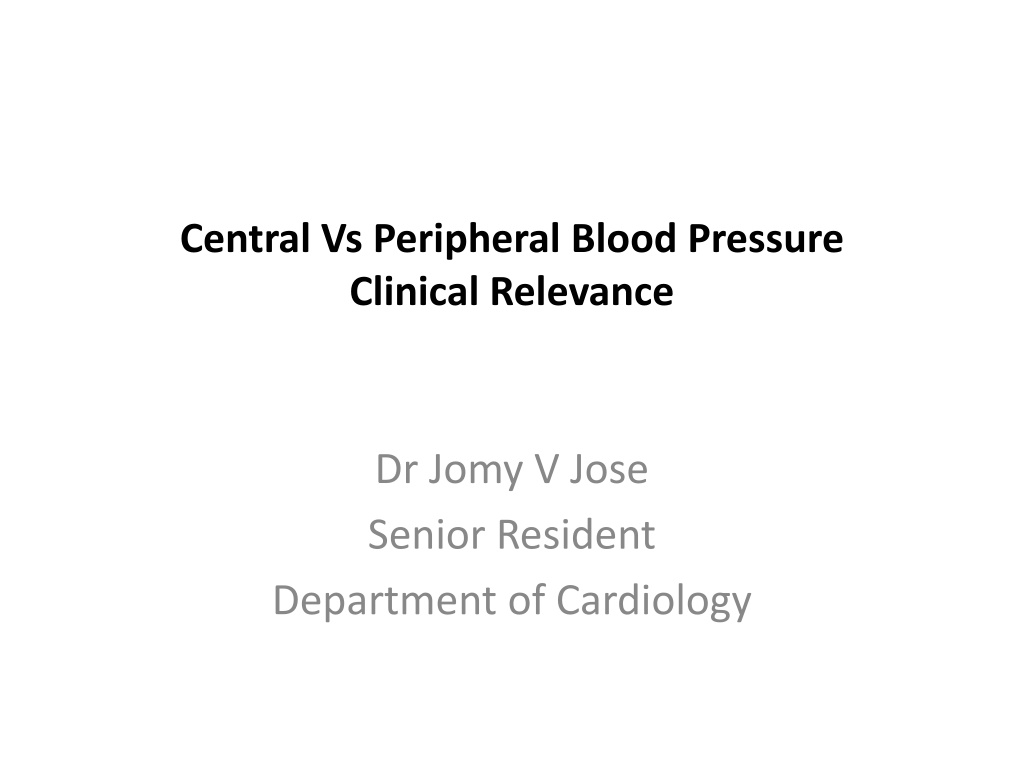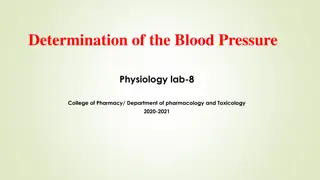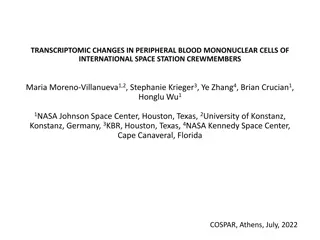Understanding Central vs Peripheral Blood Pressure: Clinical Relevance
Central vs peripheral blood pressure differences have clinical implications as systolic pressure amplification occurs due to changes in arterial stiffness moving away from the heart. Central pressure measurements, more closely related to cardiovascular events, provide valuable insights for assessing cardiovascular risk factors such as carotid intima-media thickness and left ventricular mass. Various methods, including invasive and non-invasive techniques, are used to measure central pressure accurately.
Download Presentation

Please find below an Image/Link to download the presentation.
The content on the website is provided AS IS for your information and personal use only. It may not be sold, licensed, or shared on other websites without obtaining consent from the author. Download presentation by click this link. If you encounter any issues during the download, it is possible that the publisher has removed the file from their server.
E N D
Presentation Transcript
Central Vs Peripheral Blood Pressure Clinical Relevance Dr Jomy V Jose Senior Resident Department of Cardiology
Blood Pressure The shape of the pressure waveform changes continuously throughout the arterial tree. Although diastolic and mean arterial pressures are relatively constant, systolic pressure may be up to 40 mmHg higher in the brachial artery than in the aorta. This phenomenon of systolic pressure amplification arises principally because of an increase in arterial stiffness moving away from the heart.
As the pressure wave travels from the highly elastic central arteries to the stiffer brachial artery, the upper portion of the wave becomes narrower, the systolic peak becomes more prominent, and systolic pressure increases
Arterial waveform analysis, assumes that the arterial pressure waveform is a composite of a forward travelling wave, generated by left ventricular ejection, and a backward-travelling reflected wave arising from sites of impedance mismatch i.e. arterial taper and differences in vessel stiffness, which often occur at bifurcations. This change in impedance is thought to generate numerous reflected wavelets that sum together to produce a single effective reflected wave, which is thought to augment, or increase systolic pressure in the central arteries.
How to Measure Central Pressure The most direct method involves cardiac catheterization and recording of the blood pressure in the ascending aorta using a pressure- sensing catheter. Non-invasive methods, where pressure waveforms are recorded from sites distal to the aorta, such as the carotid, radial or brachial arteries, and calibrated to blood pressure recorded by cuff sphygmomanometry.
The heart, kidneys, and major arteries supplying the brain are exposed to aortic rather than brachial pressure. Therefore, there is a strong rationale to believe that cardiovascular events may ultimately be more closely related to central rather than brachial pressure. Central pressure is more closely correlated with widely accepted surrogate measures of cardiovascular risk such as carotid intima- media thickness (CIMT) and left ventricular mass (LVM), than brachial pressure in cross- sectional studies
Longitudinal observations provide greater support for the potential value of central pressure measurement. In the REASON Study, regression of LVM was more strongly related to change in central compared with brachial pressure and, after adjustment, only central pressure remained predictive. Similar observations were made in a substudy of ASCOT. Moreover, with anti-hypertensive therapy, the reduction in CIMT relates better to the fall in central pressure
ANBP2 and Framingham Heart Study Did not detect any systolic pressure amplification between the carotid and brachial arteries and concluded that there was no advantage in assessing central in addition to brachial pressure.
Strong Heart Study Central pressure was more strongly related to future cardiovascular events than brachial pressure, in disease-free individuals.
The main issue with the existing studies is that they are relatively underpowered to show convincingly that central pressure is meaningfully superior to brachial values in predicting events
Beta Blockers Beta blockers exert differential effects on brachial Vs central pressures. MRC Elderly LIFE ASCOT The CAFE substudy of ASCOT trial : Individuals randomized to Atenolol had a 4.3 mm of Hg higher central systolic pressure than those given Amlodipine despite identical brachial pressures.
Most studies are with Atenolol Bisoprolol also showed same results But newer vasodilatory beta blockers like Nebivolol and Celiprolol may have different effects
Nitrates Although not classical antihypertensives outside the emergency setting, chronic high doses of nitrates do reduce brachial pressure despite concerns over tolerance. Limited data also suggests low doses may reduce central pressure with no effect on brachial pressures.
Hills Sign Sign or Artefact ?
There is difference of opinion in the literature regarding the reliability of Hill's sign. Some studies have shown that Hill's sign is a useful indicator of aortic insufficiency but others have shown that there is no difference in systolic blood pressure in arms & legs in aortic regurgitation and hence Hill's sign should not be used as an indicator of aortic regurgitation.
Braunwald Says The Hill sign( an exaggerated difference in systolic blood pressure between upper and lower extremities) is an artifact of sphygmomanometric measurements and is no longer considered a sign of AR . Hutchison, Macleods, Oxford don t mention Hills sign
For noninvasive BP measurement a Standard mercury sphygmomanometer was used to take blood pressure readings in the arm and leg. Cuff size of atleast 40% of limb circumference was used i.e. for arm - l2-cm. width and for thigh - 19-cm. width.
The present study indicates that in aortic insufficiency, intra-arterially there is no difference in systolic pressures between upper & lower limb. It is an ar tifact of sphygmomanometeric lower limb pressure measurement. Hill's sign is largely the result of the use of inappropriate small size of cuff in the lower limb. With the use of appropriate sized cuff, Hill' sign is absent in most of the patients with severe AR.

























